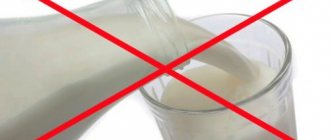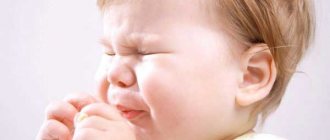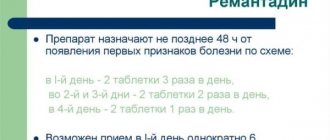Causes of hoarseness
Changes in voice timbre in children are associated with changes in the normal functioning of the structures of the larynx:
- vocal cords;
- subglottic space;
- mucous membrane;
- cartilage.
The vocal cords are the human sound-reproducing apparatus, which works properly due to their rapid vibration.
A change in their elasticity and an increase in size due to inflammation or swelling causes a change in the timbre of the voice - it becomes quiet, hoarse, hoarse or disappears completely.
The intensity of the voice change depends on the degree of damage to the larynx.
The rapid change in voice in children is associated with the structural features of the child's upper respiratory tract - the tissues are equipped with a huge number of blood vessels located superficially, and the submucosal layer has a loose structure.
When the larynx is exposed to pathological microorganisms or irritating factors of non-infectious origin, a local inflammatory process develops and the filling of the mucous membrane with blood increases.
This causes pronounced swelling of the vocal cords and narrowing of the glottis, which ultimately results in hoarseness.
With chronic inflammation of the larynx, which sometimes occurs in schoolchildren and adolescents, the vocal cords gradually thicken, and after a certain period of time nodules and ulcers appear on them.
Reasons for voice changes in children of different ages
In infants
The voice of an infant can change as a result of physiological reasons without any apparent reason at the beginning of the second month of life, and this is associated with differentiation, restructuring and overstrain of the vocal cords. This is due to the baby’s adaptation to new living conditions. This condition goes away on its own.
Also, one of the main reasons for changes in the voice of a baby is observed with loud screaming and prolonged crying due to prolonged overstrain of the laryngeal ligaments.
In young children
Causes of hoarseness include:
- acute inflammation of the nasopharynx and/or larynx (laryngitis and laryngotracheitis) due to colds, viral diseases or childhood infections (measles, rubella, severe chickenpox, scarlet fever), often these pathologies are accompanied by swelling of the larynx - “false croup”;
- inflammation of the nose, pharynx and larynx of an allergic nature;
- adenoiditis;
- fear or severe stress;
- congenital stridor and other anomalies of the larynx;
- foreign body in the larynx;
- neoplasms on the vocal cords (polyps, fibroids, cysts).
In preschoolers
Most often, hoarseness in children is observed:
- for laryngitis and laryngotracheitis of a viral and bacterial nature, most often with parainfluenza, rhinosyncytial infection, pneumococcal lesions of the larynx, Haemophilus influenzae infection;
for inflammation of the larynx due to childhood infections;
- with adenoid growths in the nasopharynx and adenoiditis;
- for acute pharyngitis and tonsillitis;
- for psychoneurological pathologies (neuroses, severe stress, fear);
- with pathology of the digestive tract with reflux of stomach contents from the esophagus into the nasopharynx;
- with neoplasms of the larynx.
In schoolchildren and teenagers
- acute and chronic inflammation of the nasopharynx with the transition of inflammation to the structures of the larynx;
- allergic laryngitis;
- overstrain of the vocal cords when shouting, singing, or talking for a long time;
- neurological pathology;
- voice mutation in boys during puberty;
- chronic gastrointestinal diseases;
- laryngeal injuries;
- laryngeal neoplasms
The child’s voice is hoarse – what should I do?
Sometimes parents notice that the child wakes up hoarse in the morning and clears his throat and recovers for some time after waking up. This phenomenon is due, according to Evgeniy Komarovsky, to the fact that in the larynx, in particular in the area of the vocal cords, the natural secretory mucus dries out at night.
This happens because the baby breathes too dry air. Just moisturize it and the nighttime hoarseness will stop.
This symptom is alarming. If ARVI has already been left behind and the baby feels better, then sudden hoarseness may indicate the addition of a secondary infection, very likely bacterial. You should not wait to see whether it will go away on its own or whether difficulty breathing will still appear, but you should immediately call a doctor at home.
With colds and respiratory diseases, children often develop hoarseness, so the question of how and how to treat a child’s hoarse voice is relevant for many parents. Medicines and folk remedies, as well as Dr. Komarovsky’s advice, will help you get rid of unpleasant symptoms.
When a child has a cold, his or her voice often disappears.
Hoarseness often appears in a child against the background of prolonged tension in the ligaments; this happens in infants after prolonged crying or screaming. If there are no signs of a cold, it is necessary to find out and eliminate the cause of the newborn’s increased moodiness; after a few days, the unpleasant symptoms will disappear on their own.
Hoarse voice – main reasons:
- infectious processes in the larynx and oropharynx - sore throat, tracheitis, laryngitis;
- the presence of papillomas and other neoplasms in the larynx;
- neck injuries;
- damage to mucous solid food;
- dehydration;
- if the voice disappears after an illness, this may indicate a bacterial infection;
- age-related changes in the voice during puberty - at the age of 13–14 years, boys begin to undergo hormonal changes in the body, which also extends to the vocal ligaments.
Sore throat can cause a hoarse voice
With colds and infectious pathologies, in addition to a hoarse voice, a runny nose, dry cough, sore throat, tonsils and throat become red, increased temperature and sweating, enlarged cervical lymph nodes, fatigue, and decreased appetite appear. Treatment of such pathologies can be carried out at home; therapy is aimed at eliminating unpleasant symptoms and restoring immunity.
Ingoda hoarseness occurs without fever, there is no cough, but such situations pose a danger to the child’s life, it is necessary to immediately call an ambulance.
Dangerous causes of hoarseness:
- Quincke's edema is a dangerous type of allergic reaction, swollen tissues compress the larynx, which prevents the child from breathing normally, the pathology is accompanied by profuse lacrimation, rash, itching, and nasal congestion;
- laryngeal stenosis - develops against the background of injuries to the esophagus by foreign objects, allergies, scarlet fever, burns, at the initial stage breathing is difficult, gradually becomes very noisy, shortness of breath appears, the face and neck swell, suffocation develops;
- foreign body in the respiratory tract - this problem often occurs in young children who put small objects into their mouths, the child quickly begins to choke, the skin becomes bluish, and a paroxysmal cough appears;
- croup is a consequence of diphtheria, measles, and some forms of tonsillitis, most often occurring in children aged 2–5 years.
Laryngeal stenosis causes hoarseness and difficulty breathing.
If you suspect the presence of a foreign body in the respiratory tract, you need to briefly turn the baby upside down, then put the child on the adult’s left thigh, press his legs, and pat him on the back. You can grab an older child with your arms from behind, place your fist on the upper abdomen, cover it with the palm of your other hand, and make quick pressing movements from bottom to top.
Proper therapy will help quickly cure hoarseness and restore your voice; for this it is necessary to use medications and alternative medicine in combination.
Additional conditions for a quick recovery are complete rest, frequent wet cleaning, hot and cold foods and drinks should be excluded from the diet, drink more warm milk with water, still mineral water, fruit drinks and compotes.
Medicines
In the treatment of hoarseness, various drugs are used in the form of tablets, sprays, and solutions. The choice of drugs depends on what caused the development of the pathology.
A voice sat down asking how to treat a child:
- antiseptic rinsing solutions - Chlorophyllipt, Miramistin, Furacilin;
- throat sprays with analgesic, anti-inflammatory, softening effects - Ingalipt, Tantum Verde, Kameton;
- lozenges and lozenges with antimicrobial action - Lizobakt, Faringosept, Strepsils;
- preparations for lubricating the pharynx - Lugol;
- cough medicines – ACC, Gerbion;
- antihistamines to reduce swelling - Fenistil, Suprastin;
- inhalation with a nebulizer with Pulmicort, Ambroxol;
- vitamin complexes – Alphabet, Supradin.
Chlorophyllipt - solution for gargling
Additionally, symptomatic treatment is carried out with antiviral and antibacterial drugs; if the temperature rises above 38 degrees, antipyretics should be taken - Panadol, Ibuprofen.
Treatment of thermal, mechanical, and chemical lesions of the throat is carried out only in stationary conditions.
Alternative medicine will help cope with swelling and inflammation, they strengthen the immune system and promote a speedy recovery.
How to relieve hoarseness - simple recipes:
- Add 10 g of butter and 5 ml of honey to 230 ml of warm milk - this drink eliminates irritation and softens the mucous membrane.
- You can gargle with a solution of 240 ml of water and 15 ml of honey, carry out the procedure 2-3 times a day.
- Gogol-mogol is a tasty and healthy medicine that helps with various throat diseases. Beat 2 yolks, add 450 ml of milk, 50 ml of honey and 30 ml of fresh orange juice. Heat the mixture a little in a steam bath, add 2 egg whites beaten with sugar.
- Wash the black radish, cut off the top, make a small hole, fill it with honey, leave for 5-6 hours. Give the child 2 tsp. juice 3-5 times a day. The medicine helps to cope with dry cough.
- For rinsing, you can use an infusion of chamomile inflorescences, calendula, eucalyptus leaves, sage - 20 g of crushed raw materials, brew 350 ml of boiling water, leave in a sealed container for 20-30 minutes, strain. The procedure should be carried out an hour after eating; you should not drink or eat for 30 minutes after rinsing.
- Essential oils of fir, menthol, eucalyptus, and tea tree are suitable for steam inhalation. You need to breathe the steam for 5–10 minutes, depending on the age of the child.
It is better to use acacia honey to treat children; it is considered hypoallergenic.
Black radish with honey helps get rid of hoarseness of voice
If a child has hoarseness, Dr. Komarovsky recommends starting treatment with plenty of warm alkaline drinks, rest and the use of local antiseptics. You should not immediately use antiviral drugs or antibiotics; such strong drugs should only be prescribed by a doctor after examination and diagnosis.
But if a child, in addition to hoarseness, has noisy breathing with difficulty inhaling, a rough barking cough, then these are characteristic signs of viral or false croup.
This condition often develops against the background of ARVI, measles, chickenpox, scarlet fever, and requires immediate medical attention. Before the doctor arrives, the baby should be dressed warmly, breathe fresh air, and given a warm raisin decoction or dried fruit compote to drink.
The most dangerous thing in such a situation is dry air and heat in the room, self-medication.
Prevention
To avoid hoarseness, parents should pay special attention to the child’s immunity.
How to prevent a hoarse voice:
- do not refuse vaccination against diphtheria - hoarseness is one of the first signs of this dangerous disease;
- Breastfeeding will help develop a strong immune system in the child;
- create a correct and balanced diet with plenty of vegetables, fruits, cereals, limit foods with fast carbohydrates;
- children should move a lot and spend more time outdoors;
- do not forget about hardening;
- maintain optimal temperature and humidity in the room;
- Stress, lack of sleep, overwork weaken the immune system.
Allow your child to be vaccinated against diphtheria
A good way to prevent and strengthen local immunity is ice cream; if a child eats this product regularly in small portions, then he will be much less likely to suffer from colds and sore throats.
A child’s hoarse voice may be a sign of viral or bacterial infections; often unpleasant symptoms are a consequence of incorrect temperature conditions in the room. But if the baby suddenly becomes hoarse and has breathing problems, then this is a sign of serious and life-threatening illnesses - urgent medical attention is needed.
A child has a hoarse voice when crying for a long time
One of the reasons for hoarseness in young children is prolonged screaming. It negatively affects the sensitive tissues of the larynx, as a result of which swelling of the ligamentous apparatus develops, and small bubbles appear in the soft tissues. Parents often believe that there is nothing wrong with this - neither prolonged crying, nor a change in the timbre of the voice. But this is not so - in children at this age, all processes of the nervous system are unstable, and the structures of the larynx are not mature enough and are tender, so a hoarse voice appears for a long time, in addition, nervous disorders often develop in the form of various neuroses.
Persistent hoarseness with frequent crying and/or intense screaming against the background of insufficiently formed vocal cords is associated with the formation of specific protrusions on their surface in the form of small nodules, which prevent them from tightly closing with constant vocal strain.
In the future, this can cause frequent manifestations of colds and viral infections in the form of laryngitis and “false croup,” which is extremely dangerous in children of early and preschool age.
Therefore, parents need to remember that they should not allow their baby to cry and scream for no reason - this may negatively affect his health in the future.
Hoarseness with a cold
The most common cause of hoarse voice in children at any age is:
- colds;
- viral and bacterial infections.
Inflammation and swelling of the vocal cords of a cold origin occur as a result of hypothermia in a child.
In children, this in most cases develops due to instability of the thermoregulation system and reduced intensity of blood circulation in the hands and feet.
Experts recommend creating a comfortable microclimate in the room - maintaining the air temperature in the baby’s room at 22-23 degrees Celsius.
But this temperature regime is not suitable for all children; for some categories of children it is selected individually.
These include:
- weakened children;
- children with perinatal pathology, signs of congenital infection and other somatic diseases.
It is also necessary to remember that there is a separate category of “heat-loving” young children, which is explained by incomplete differentiation of thermoregulation and these children can catch a cold from the parents’ harmless desire to harden the baby from the cradle.
You can understand that the selected temperature regime is not suitable for the baby by constantly cool arms, legs and nose of the child, which remain cold - this means that the temperature in the room should be higher than recommended.
Parents need to remember that each child is individual, so sleep and wakefulness, microclimate conditions, nutrition and other features of the baby’s growth and development are selected in accordance with the functional characteristics of the body.
Hoarseness with viral and bacterial laryngitis
In addition to colds, the main cause of inflammation of the larynx in children is considered to be viral infections:
- parainfluenza;
- rhino-syncytial;
- adenoviral;
- influenza virus.
They are accompanied by signs of catarrhal inflammation:
- voice change;
- runny nose and nasal congestion;
- increased body temperature;
- coughing;
- weakness, lethargy;
- anxiety;
- refusal to eat and regurgitation.
Laryngitis is an inflammatory process in the larynx with swelling of the mucous membranes and vocal cords.
In childhood, acute stenosing laryngitis (false croup) is identified as a separate form, which can lead to dangerous consequences for both the health and life of the child.
The larynx in young children is narrower, and with severe swelling of the ligamentous apparatus, its lumen is almost completely blocked, and the baby may die from suffocation without emergency medical assistance.
Catarrhal laryngitis is manifested by hoarseness, coughing, sore throat, runny nose and is the mildest form of the disease.
You need to know the dangerous symptoms of the disease:
- dry, “barking” irritating cough;
- low and deep voice;
- difficult noisy breathing with increased inhalation and whistling, which may be accompanied by respiratory movements with retractions of the intercostal spaces;
- difficulty swallowing;
- increased salivation;
- signs of “lack of air.”
If even mild hoarseness appears in a baby or if alarming symptoms occur, parents should:
- seek medical help to determine and eliminate the cause of the disease (coldness, acute viral infection, allergy);
- strictly follow all doctor’s recommendations.
An allergic reaction can also cause acute laryngotracheitis.
Causes
The larynx contains vocal cords, which are directly involved in the formation of sounds.
These ligaments themselves are very mobile. However, their mobility is easily impaired and modified if swelling and inflammation occurs in the throat, where the ligaments are attached. Many parents mistakenly believe that if a child has a hoarse voice, then this is solely a consequence of hypothermia or a cold.
- Most respiratory viruses enter a child's body through the nose, and this leads to a runny nose. Mucus, which is produced in response to the penetration of a foreign foreign agent, accumulates and disrupts nasal breathing. But some of the viral particles survive and pass further - through the nasopharynx into the larynx, and there an inflammatory process begins, which changes the functioning parameters of the vocal cords.
- The second most common reason, according to Evgeniy Komarovsky, is an allergic reaction. The antigen protein, which is foreign to the baby’s immune system, causes rejection towards itself, and therefore the allergy is quite “inventive” for various symptoms, including sore throat.
- Hoarseness can occur after a trauma to the larynx, for example, from a burn, if the child swallowed something very hot. Often, caring mothers, in an attempt to quickly cure their baby of ARVI or flu, do steam inhalations, during which the child also receives a burn to the mucous membrane of the throat. After such “procedures,” a sick, but not hoarse child becomes hoarse.
- Also, the voice may become hoarse after a long, heart-rending scream from mechanical injury to the vocal cords. This goes away on its own - the ligaments recover quite quickly.
- Less commonly, but this can also happen, inflammation in the throat is caused by bacteria. Typically, such an illness will not only be accompanied by hoarseness, but also high fever.
Pregnancy, children {amp}gt; Child health {amp}gt; Hoarse voice in a baby: causes and treatment of pathology
A hoarse voice in an infant is a fairly common phenomenon that can be observed under the influence of various unfavorable factors.
When this pathological condition appears, it is necessary to begin treatment immediately. Otherwise, complications may occur.
Causes of pathology
A hoarse voice in a newborn can be observed under the influence of various factors:
- Prolonged crying. This reason is the most common. That is why parents must provide comfort to the baby.
- Cold. Most doctors recommend keeping the temperature of the room where the baby is at 22 degrees. But for some children this indicator is insufficient. This is why hoarseness may occur.
- Laryngitis. With this disease, the development of an inflammatory process in the mucous membranes of the larynx is observed. Hoarseness in most cases is observed during the course of the catarrhal form of the disease.
- Tracheitis. It is an inflammation that develops in the trachea. The cause of this disease is hypothermia, as well as infectious diseases.
- The pathological condition can develop during the course of various colds.
Hoarseness may be caused by injuries to the larynx. They occur when there is an accidental blow to the front wall of the neck. In this case, the child must be hospitalized. If foreign objects get into the throat, hoarseness may also occur.
There are many reasons for the occurrence of a pathological process. That is why parents need to be as attentive as possible to their baby.
Features of treatment
When hoarseness occurs, a newborn child is prescribed individual treatment, which directly depends on its cause.
Only a doctor can determine the provoking factor and prescribe rational treatment. That is why you should not put off visiting a specialist.
In some cases, there is a need for urgent hospitalization of the newborn. The child must call an ambulance if this symptom is accompanied by shortness of breath and a severe cough.
If you experience hoarseness, see a specialist!
Read: Causes of low body temperature in children
Treatment of various colds is most often carried out with the use of drugs that have antiseptic and anti-inflammatory properties.
The production of medicines is carried out in the form of syrup, which ensures the most comfortable treatment for infants.
Treatment of a hoarse voice is carried out only after preliminary consultation with a specialist, which will ensure its effectiveness.
If you have slight hoarseness, you can treat it at home.
If the cause of this symptom is prolonged and loud crying, then parents should try to calm the baby in any way. It is not recommended to give the child anything to eat until the doctor arrives. Consumption of hot or cold drinks is strictly prohibited. You can give your baby tea that is at room temperature.
Some infants are recommended to undergo inhalations using aroma oil. This product softens the skin and relieves puffiness. The procedure must be carried out with the utmost caution, since the child may develop an allergic reaction, which is quite dangerous.
If hoarseness is observed against the background of laryngitis or a cold, then its treatment should be carried out using warm milk. Soda is first added to it in the amount of one pinch. To make the drink more pleasant for the baby, you need to add a little honey and one teaspoon of butter to it.
If an infant has a pathological condition, then experts recommend holding it over steam for a short period of time. Taking steam baths is allowed only in the absence of elevated body temperature.
Therapy depends on the cause of the pathology
Read: Feeding, sleeping, staying awake in the mode of a 2 month old baby
Drug therapy can be used to treat the pathological condition. The selection of a specific drug directly depends on the results of the examination.
In some cases, newborn babies are prescribed antibiotics or antimicrobials. These medications can only be used in the presence of a bactericidal infection. Quite often, symptomatic therapy is prescribed to treat young patients.
If a child experiences an increase in body temperature, he needs to take anti-inflammatory medications. If spasms are present, children are prescribed bronchodilators.
A hoarse voice in a baby can occur due to a variety of diseases. In order to prescribe rational treatment for a pathological condition, it is necessary to examine the child.
This is why parents should take their newborn to the pediatrician. Only after determining the cause of the pathology can the child be prescribed the correct treatment.
For this purpose, pharmaceutical preparations or traditional medicine are used.
Select it and press Ctrl Enter to let us know.
30 Jul 2020 Yuki 147
Treatment of a hoarse voice in a child
If a baby's voice changes due to crying, treatment consists of putting the baby to the breast more often or drinking plenty of warm water.
The baby needs to pay more attention so that he does not strain his vocal cords (cry and breathe through his mouth):
- pick him up;
- calm down;
- It is necessary for someone to be constantly with the sick child - stenosis can begin at any time.
Treatment of inflammatory diseases that cause hoarseness is prescribed by a doctor.
Swelling and inflammation in infants develops quickly and suddenly in the early morning or at night (in 2-3 hours, sometimes less).
In older children, it is necessary to clarify the cause of hoarseness.
General recommendations for voice restoration are:
- complete vocal rest - the child must be silent for 1-3 days, you cannot speak even in a whisper;
- warm, abundant drink - thermal alkaline water, milk with honey, soda or Borjomi, decoctions of anti-inflammatory herbs;
- proper nutrition - warm pureed mucous dishes, light broths, stewed vegetables, baked fruits;
- maintain indoor air humidity at 50-60%;
- breathing exercises - they begin immediately after the appearance of hoarseness - first you need to take a deep breath of air through your mouth and exhale slowly, pursing your lips into a tube, repeat 10 times three times a day.
What not to do and take if you have hoarseness:
- completely exclude vasoconstrictor drops from the course of treatment, even if the child has nasal congestion;
- Do not use irritating and allergenic sprays and absorbable agents - Propasol, products with menthol and eucalyptus (they often dry out the mucous membranes and increase swelling);
- Steam inhalations are not performed, it is better to use a nebulizer;
- completely eliminate smoking, energy drinks and other drinks containing caffeine;
- exclude from the child’s diet foods that irritate the throat - sour, fried and spicy, marinades, hot and carbonated drinks.
Hoarse voice in a baby: causes and treatment of pathology
Treatment depends on the cause of hoarseness.
For acute respiratory viral infection, no specific therapeutic measures are necessary.
And no heaters. Additionally, you can instill a saline solution into your nose and gargle with it.
If a child has an allergy, he will definitely need to consult an allergist, who will help determine, using special tests, the type of allergen that caused the body’s inadequate reaction. Treatment consists of eliminating the cause of the allergy. In severe cases, antiallergic antihistamines are prescribed.
In case of bacterial inflammation, the doctor will definitely prescribe antibiotics to the child. Which ones exactly will become clear upon examination and analysis of other symptoms. Typically, these are drugs of the penicillin group.
When an injury occurs, a child needs rest. And this will be the main medicine. You should play silently, and do not try to talk at any cost.
In severe cases, the doctor will recommend rinsing with furatsilin, treating the larynx with an antiseptic such as Miramistin, and inhalations with special adrenaline-based compounds that cause spasm of the laryngeal vessels. As a result of their use, swelling decreases, the glottis opens, and breathing is restored.









